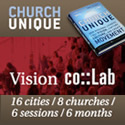Building the Perfect Church: eeing the Church Through (Blinding) Rose-Colored Glasses
- Posted by: Todd
- Posted on: Thu, March 03, 2005
- Viewed 42
- (3) comments so far

Seeing Through (Blinding) Rose Colored Glasses
As most adults know, communication breakdowns are a major cause of marital difficulties. Counselors will often design ways for couples to more effectively communicate to one another, and this is good. But consider, if communication between two people can readily break down, how much more is this the case when the 2 becomes 20, 200, or 2000? In organizations, of which the church is one, this can be a very serious problem. Exacerbating this problem, consider the three following observations about organizational life:
“Information that comes in at the bottom of the hierarchy is filtered as it goes up the hierarchy, and by the time it reaches the top it may produce images of the world that are quite unrealistic. This is particularly true of bad news.‿ (Kenneth Boulding).
“The higher you are promoted in an organization, the more insulated you become from the realities of people at lower levels‿ (Michael Doyle and David Straus).
“Bad news is unlikely to get to the people who can actually do something about it‿ (Chip Heath).
The reality is, leaders typically know less of an organization's reality than they realize, and what they do know tends to be overly optimistic – seen through (blinding) rose colored glasses. Without a system in place to process people's concerns, the pastors or other church leaders typically will not hear about problems until they are in their latter, often destructive, stages.
A few years ago, I was writing an analysis for one church. A couple of days before my interviews with the two associate pastors, a family in the church resigned their membership. This caught both associates off guard. Nothing had been said by the family to indicate that a problem existed. Prior to their letter, the family indicated they didn't feel comfortable vocalizing their concerns. In essence they said, “if everything is so great at the church, who are we to criticize?‿
The Missing Nail: Do Church Without It At Your Own Peril
The “perfect church‿ is one where love for the Lord and one another are the highest priorities. But with the four overlapping areas that impact every congregation, and increasing numbers of people, it is a delicate balancing act. What can preserve alignment is a process that is designed to convert tension into energy leading to a more effective ministry and deeper interpersonal relationships. The particular system I offer churches, the “Guardian,‿ is based on the most fundamental theological tenants of Scripture. It also meets the need spoken of by Dr. Jeffery Gaskins in his doctoral dissertation. “The research supports the conclusion that only as churches carefully use conflict management strategies can church growth strategies facilitate sustained growth.‿
Building the perfect church is no easy task. Having a system in place that serves as a central processor of tensions will preserve the kind of long-term stability that church communities absolutely need. It is the mechanism that can change interpersonal conflict, an inevitable reality where two or more people exist, from a negative force to a positive one. This is the nail that is all too often missing. And as we know, “for want of a nail…‿
Discussion
Share with the rest of us those systems or processes that have served your churches well. How did they work? What was their Biblical basis? Conversely, are there situations that required a “conversion mechanism‿ that was not available? What was the outcome? On reflection, what do you think could have been in place that would have made a positive difference?
--
© 2005 Kenneth C. Newberger Ken Newberger, an experienced church conflict resolution specialist, earned his Th.M. from Dallas Theological Seminary, has ten years senior pastoral experience, and is in the dissertation phase for his Ph.D. in Conflict Analysis and Resolution at Nova Southeastern University, one of only two accredited doctoral programs of its kind in the United States. If your church needs help resolving conflict, if you need individual coaching, or if you would like to introduce a proactive conflict management system into your church, please visit Ken's website at http://www.ResolveChurchConflict.com or call 301-253-8877.
No matter how good the structure, the other three components, culture, interpersonal interactions, and individual behavior are also part of the mix. Without a nail holding all four of these areas in place, destructive conflict is inevitable because no mechanism is in place to convert conflict into a positive force.
Comments
if you want a Globally Recognized Avatar (the images next to your profile) get them here. Once you sign up, they will displayed on any website that supports them.






bernie dehler on Thu, March 03, 2005
“Share with the rest of us those systems or processes that have served your churches well.”
I once attended a church where the Pastor had a characteristic of listening and asking questions. It was refreshing, and served as a role-model for me. It was so different than usual… usually the Pastor is quick to sermonize on any issue (he’s the “expert” on all things)… as if listening and asking are weaknesses…
...Bernie
http://www.oneplace.com/ministries/247
Jim Ziessler on Mon, March 07, 2005
Unfortunately I have seen the Organizational CR fulfilled in the negative. I was an associate Pastor at a relatively good size church (1,250) for 13 years, and I saw the attendance move to around 650 because of a pastoral change. Change in and of itself can be very positive and energizing. However,In five years I experienced seven of my collegues leave because of burn-out, lack of functional communication between associates, lack of vision and poor management and care of staff members. Morale and a feeling of good will was, for me, at an all time low. If your Organizational CR is a template I can see everyone of those violated or fulfilled depending on your perspective.
I’m certainly not one for going back to the good old days, but if you must change, change for the better not a backward turn. I recently resigned myself from my position because of a lack being able to resolve some of the conflicts outlined. The experience was painful and disheartening. I had wrestled for five years with the new management and I believe, along with the seven who left, that it was best to leave in order to preserve unity of the Body. Promises became nice words with little or no impact.I believe in an organizational structure which not only embodies Scriptural principles, but carries them out in everyday office and ministry life. When love pretains only in “loving” the central figure in order to prop him up and leave everyone else on staff neglected, then we have a co-dependant, unhealthy situation which causes a breakdown in every other area of organization and ministry. Too often challenges to create new vision, new energy and revitalization of ministry was met with indifference, intellectual side stepping and even resistance. Words of risk taking, creative planning, we just words when put to the test of practical and strategic planning.
I also must admit that I was part of the problem. My desire to see growth, inspire new energy and vision may not have been what the emerging new pastor desired. We parted friends and I pray for him regularly. But I am still haunted by the fact that I failed to fulfill what I feel God called me to do in that Body of believers.
Daniel Zepeda on Sat, April 23, 2005
Jim said: “I believe in an organizational structure which not only embodies Scriptural principles, but carries them out in everyday office and ministry life. When love pretains only in “loving” the central figure in order to prop him up and leave everyone else on staff neglected, then we have a co-dependant, unhealthy situation which causes a breakdown in every other area of organization and ministry.”
This is one of the main problems today in the institutionalized church. One central figure that demands everything revolve around him. In this situation there is no attempt to have CR in subordinates whose only option is to leave.
Page 1 of 1 pages
Post a Comment